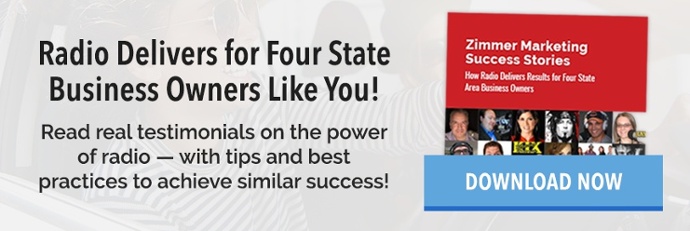 Radio advertising is far from “dead.” In fact, radio advertising continues to bring a high 12:1 return on investment, and more than 71.6 million Millennials alone use the radio on a monthly basis. Even more, radio personalities have tremendous influence, with 8 out of 10 listeners indicating they would consider trying something their favorite radio personality recommended.
Radio advertising is far from “dead.” In fact, radio advertising continues to bring a high 12:1 return on investment, and more than 71.6 million Millennials alone use the radio on a monthly basis. Even more, radio personalities have tremendous influence, with 8 out of 10 listeners indicating they would consider trying something their favorite radio personality recommended.
Radio is highly effective as part of an overall marketing plan, but it does need to be done well. If you’re preparing for your first radio spot, here are six things to consider to make it as effective as possible.
1. Understand Your Target Audience
Just like other forms of marketing, knowing your target audience will help you reach them effectively. For radio, take the time to think through how and when your audience will listen to your ad. This will help you target the right time and provide the right information. For example, if you expect the majority of your audience to be listening during their evening commute home from work, target that time and create an ad that might make them stop on their way home and make a purchase.
2. Know the Right Station
Once you’ve defined your audience and how or when they might be listening, choose the right station. Your demographic will likely have a certain station or radio personality type that they prefer listening to. For instance, if you are targeting men, sports radio is a good option. If you are targeting women, talk radio or a specific music station may work better. Identify your audience, then choose a station that will reach them well.
3. Use the Right Frequency
Repetition aids learning, and the more your audience hears your message, the better they will retain it. In radio, the frequency of 3 is the most powerful thing to remember. It takes three times hearing an advertisement for a listener to build recognition and trust in your brand. Aim for a frequency that will reach your target listener at least three times each week. When you are planning for a year of radio spots, consider a 21/52 strategy, which involves 21 spots per week, 52 weeks per year to reach the largest number of people.
4. Keep It Simple
Long, drawn out radio spots are not effective. People need to be given the information you plan to deliver within 30 to 60 seconds, and they need a strong call-to-action (CTA). It’s also important that the CTA is easy to remember. A simple web address or phone number repeated enough that they can remember it, without writing it down, is important. You also want to provide a bit of helpful information without overloading your listener. Remember, many radio listeners listen in the car, which means they can’t jot down information, so keep it memorable.
5. Integrate Other Advertising Efforts
Your radio advertising should be integrated with other marketing tactics, including your digital advertising. This will help boost your results and keep your branding consistent. Most radio stations also offer digital products to advertisers. When choosing a radio partner, choose one that does digital too. This will help you create an integrated marketing strategy that keeps each channel consistent and unified. It also helps drive customer action while increasing your potential reach.
6. Consult a Media Partner
Your first radio spot is too important to leave to chance. Consulting with a media partner like Zimmer can help you build a strategy that reaches the right target audience with the right timing so your ad budget brings the best potential results. With a partner who understands radio advertising, you can make the best possible decisions for your advertising campaigns.
Radio, when done right, reaches the masses at the point they are ready to make a purchase. Consider these six factors when placing your first radio spot, and reach out to Zimmer today to learn how our media experts can help you launch a winning radio campaign.

